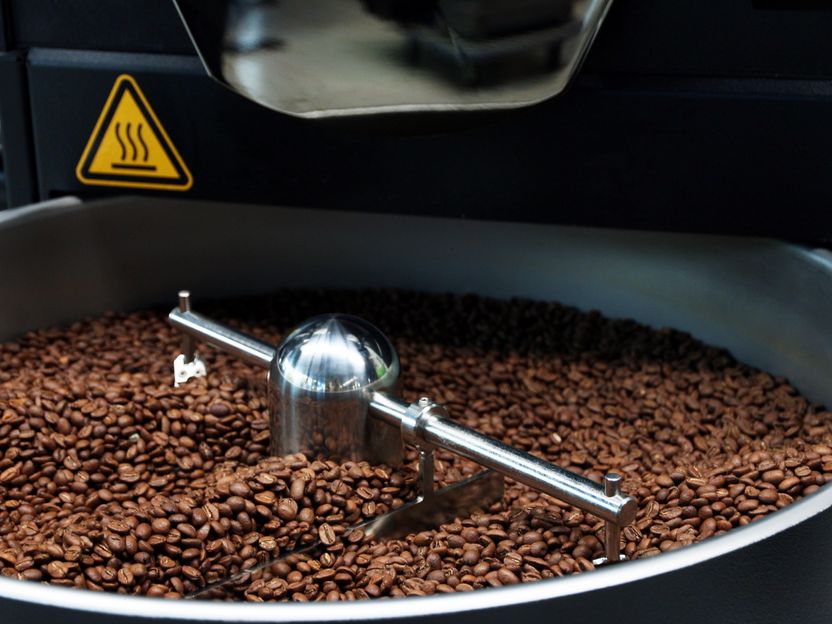Coffee roasting according to the sound of the beans
Advertisement
Coffee gets its characteristic flavor from roasting - but this process is an energy-intensive one that can result in many faulty roasts. The Probat company from Emmerich am Rhein in North Rhine-Westphalia wants to make this process more efficient in cooperation with Geisenheim University of Applied Sciences (Hesse) in a project funded by the Deutsche Bundesstiftung Umwelt (DBU). With the help of a sensor that analyzes the acoustics of the coffee beans during the roasting process, faulty roasts are to be avoided and energy and raw material consumption reduced.

Popular beans: People in Germany drank more than three cups of coffee a day last year, according to the German Coffee Association. But roasting in particular is an energy-intensive process. A project funded by the Deutsche Bundesstiftung Umwelt (DBU) aims to make this process more efficient.
Deutsche Bundesstiftung Umwelt
The building of the Probat company on the outskirts of Emmerich, just a few kilometers from the Dutch border, resembles any office complex when you walk in: file folders, open-plan offices and carpet in the corridors. What stands out, however, are the employees' sturdy safety shoes. "They are mandatory when entering the technical center," explains Sebastian Tück, project manager of the DBU-funded project. "In case something does go wrong." That's because in the pilot plant - as a preliminary stage for large-scale production - tests are carried out in meter-high industrial roasting machines "to make the coffee production of the future more efficient," says Tück. The family business has been manufacturing coffee roasting machines for more than 150 years, with other locations in India, Brazil and the USA, for example. In a few months, the sound sensor to be developed in the DBU project will also be tested under real conditions in the Emmerich technical center.
More than three cups a day per capita
Germans drink a lot of coffee. Whether black, with milk or refined with spices - according to the German Coffee Association, per capita consumption in Germany in 2021 was 169 liters, well over three cups a day. According to the association, this puts black gold in first place among the beverages consumed in Germany. As a tribute to the popular hot beverage, International Coffee Day is celebrated every year on October 1. But roasting coffee beans "is a very energy-intensive process," explains Dr. Michael Schwake, deputy head of the DBU's Environmental Technology department and supervisor of the project. With its funding, the DBU wants to show "that energy and resources need to be saved and used more efficiently in all sectors - from steel mills to coffee roasters," says Schwake.
Heat or strong movements make predictions difficult during roasting
Shortly before noon in a large meeting room. Digitally connected on the white screen are Prof. Dr. Bernd Lindemann, David Kiy and Dr. Hans Gerd Severin from the Institute for Food Safety at Geisenheim University. On the conference table in Emmerich is a coffee pot of the home-roasted house blend. Project manager Tück and Thomas Koziorowski, technical director at Probat, regularly meet with the Geisenheim researchers for a digital cup of coffee to discuss progress on the project. "The beans don't make it easy for us," Lindemann said. Varying parameters during roasting, such as heat, the strong movements of the beans or the many different types of coffee, make investigations and predictions about the degree of roasting difficult, he said. "How long the beans are roasted is essentially determined by experience and observation," Lindemann explains. Standard roast masters manually checked the progress of roasting based on the color of the beans.
Color and sound of the coffee beans indicate roasting progress
To optimize this process, the team's first step is to use a laser to determine the color during roasting. The problem: "There is always a difference between the outer and inner color of the beans," Lindemann says. "Imagine a cake that is burnt on the outside but not yet cooked through on the inside." So the researchers want to approach the inner state of the beans in a different way. "We're not just looking at the beans, we're also listening closely," the scientist says. The coffee beans become larger and lighter during roasting, he says. As a result, he says, the sound changes during the roasting process. "In addition to color determination using lasers, we also want to use the sound sensor and the associated measurement method to gain information on the internal structure of the beans," Lindemann summarizes.
Initial laboratory tests positive
The project team is optimistic. "Initial laboratory tests have shown a correlation between elapsed time during roasting and acoustics," says Lindemann. Now the method will be tested in more complex roasting machines and a database will be fed with the results of the measurements. The long-term goal: "A computer analyzes the data from the roaster and provides information about the roasting progress within seconds," says Tück. With the help of this data, roasting can be stopped at the right time. The research team hopes that this will result in energy savings of up to 25 percent: "Incorrect roasts will no longer occur so frequently. At the same time, this means that fewer coffee beans will be wasted," Tück continues. According to him, this saves resources in coffee cultivation and energy in processing the beans.
Note: This article has been translated using a computer system without human intervention. LUMITOS offers these automatic translations to present a wider range of current news. Since this article has been translated with automatic translation, it is possible that it contains errors in vocabulary, syntax or grammar. The original article in German can be found here.





























































